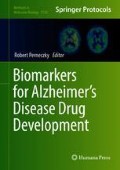Abstract
Patient data in clinical research often includes large amounts of structured information, such as neuroimaging data, neuropsychological test results, and demographic variables. Given the various sources of information, we can develop computerized methods that can be a great help to clinicians to discover hidden patterns in the data. The computerized methods often employ data mining and machine learning algorithms, lending themselves as the computer-aided diagnosis (CAD) tool that assists clinicians in making diagnostic decisions. In this chapter, we review state-of-the-art methods used in dementia research, and briefly introduce some recently proposed algorithms subsequently.
Access this chapter
Tax calculation will be finalised at checkout
Purchases are for personal use only
References
Wu X, Kumar V, Quinlan JR et al (2007) Top 10 algorithms in data mining. Knowl Inf Syst 14(1):1–37. https://doi.org/10.1007/s10115-007-0114-2
Drzezga A (2009) Diagnosis of Alzheimer’s disease with [18F]PET in mild and asymptomatic stages. Behav Neurol 21(1):101–115
López MM, Ramírez J, Górriz JM et al (2009) SVM-based cad system for early detection of the Alzheimer’s disease using kernel PCA and LDA. Neurosci Lett 464:233–238
Suk H-I, Shen D (2013) Deep learning-based feature representation for AD/MCI classification. Med Image Comput Comput Assist Interv 16(2):583–590
Schmidt J, Hapfelmeier A, Müller M et al (2010) Interpreting PET scans by structured patient data: a data mining case study in dementia research. J Knowl Inf Syst 24:149–170
Bach FR, Lanckriet GRG, Jordan MI (2004) Multiple kernel learning, conic duality, and the SMO algorithm. Paper presented at the proceedings of the twenty-first international conference on machine learning, Banff, AB, Canada
Wolpert D (1992) Stacked generalization. Neural Netw 5(2):241–259
SPM (2005) Statistical parametric mapping. http://www.filionuclacuk/spm/software/spm5/
Yakushev I, Landvogt C, Buchholz HG et al (2008) Choice of reference area in studies of Alzheimer’s disease using positron emission tomography with fluorodeoxyglucose-F18. Psychiatry Res 164(2):143–153
Li R, Perneczky R, Drzezga A et al (2015) Gaussian mixture models and model selection for [18F] fluorodeoxyglucose positron emission tomography classification in Alzheimer’s disease. PLoS One 10(4):e0122731
Bishop CM (2006) Pattern recognition and machine learning. Springer, New Delhi
Schwarz GE (1978) Estimating the dimension of a model. Ann Stat 6(2):461–464
Klösgen W (1996) A multipattern and multistrategy discovery assistant. Advances in knowledge discovery and data mining. 249–271
Lavrac N, Kavsek B, Flach P et al (2004) Subgroup discovery with CN2-SD. J Mach Learn Res 5:153–188
Li R, Perneczky R, Drzezga A et al (2015) Efficient redundancy reduced subgroup discovery via quadratic programming. J Intell Inf Syst 44(2):271–288
Li R, Hapfelmeier A, Schmidt J et al (2011) A case study of stacked multi-view learning in dementia research
Acknowledgments
Some of the proposed methods were developed during the author’s appointment at Technische Universität München (TUM), Munich, Germany. The author thanks Prof. Dr. Stefan Kramer for his academic guidance during the PhD study at Technische Universität München and Johannes Gutenberg-Universität Mainz.
Author information
Authors and Affiliations
Corresponding author
Editor information
Editors and Affiliations
Rights and permissions
Copyright information
© 2018 Springer Science+Business Media, LLC
About this protocol
Cite this protocol
Li, R. (2018). Data Mining and Machine Learning Methods for Dementia Research. In: Perneczky, R. (eds) Biomarkers for Alzheimer’s Disease Drug Development. Methods in Molecular Biology, vol 1750. Humana Press, New York, NY. https://doi.org/10.1007/978-1-4939-7704-8_25
Download citation
DOI: https://doi.org/10.1007/978-1-4939-7704-8_25
Published:
Publisher Name: Humana Press, New York, NY
Print ISBN: 978-1-4939-7703-1
Online ISBN: 978-1-4939-7704-8
eBook Packages: Springer Protocols

